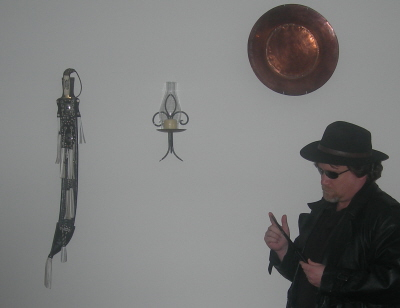|
About This Author
Come closer.
|
Complex Numbers
Complex Numbers
A complex number is expressed in the standard form a + bi, where a and b are real numbers and i is defined by i^2 = -1 (that is, i is the square root of -1). For example, 3 + 2i is a complex number.
The bi term is often referred to as an imaginary number (though this may be misleading, as it is no more "imaginary" than the symbolic abstractions we know as the "real" numbers). Thus, every complex number has a real part, a, and an imaginary part, bi.
Complex numbers are often represented on a graph known as the "complex plane," where the horizontal axis represents the infinity of real numbers, and the vertical axis represents the infinity of imaginary numbers. Thus, each complex number has a unique representation on the complex plane: some closer to real; others, more imaginary. If a = b, the number is equal parts real and imaginary.
Very simple transformations applied to numbers in the complex plane can lead to fractal structures of enormous intricacy and astonishing beauty.
December 23, 2023 at 6:45am December 23, 2023 at 6:45am
| |
Come on, now, the answer to this headline question should be glaringly, brightly obvious.
It's right here, of course. The guy typing these words. That is to say, Me.
...oh, fine. Let's see what the article says.
The farther away we look, the farther back in time we’re viewing the Universe, and the greater the amount the light from those distant objects is shifted toward longer wavelengths. A lot of people, upon hearing this, get a particular picture in their heads: the greater the amount the light is shifted, the faster these objects are moving away from us. Therefore, if you look in all directions and reconstruct, “At what point, in space, would we see all directions receding equally?” you could locate the center of the Universe.
Okay, but a hypothetical observer in a distant galaxy would see the same phenomena, do its own calculations, and find a different location for the "center."
Most of us understand, intuitively, that when objects move toward you, the waves they emit appear compressed, with their crests and troughs closer together. Similarly, when they move away from you, the waves appear the opposite of compressed — rarified — with their crests and troughs farther apart than if they were stationary. Although we typically experience this with sounds, as you can tell whether a fire truck, a police car, or the ice cream cart is moving toward you or away from you dependent on its pitch, it’s true for any wave, including light. We refer to this motion-based shift of the waves as the Doppler effect, named after its discoverer.
Back in college, I had a T-shirt with "The Doppler Effect" in a blue font on the front, and a red font on the back.
That was NOT the nerdiest T-shirt I owned.
The observations are very clear: the farther an object is from us, on average, the greater the observed redshift is. But is that because the object is actually moving through space, relative to us, when it emits the light versus when we absorb and measure the light? Or is it because there’s an overall expansion happening on cosmic scales, causing the light to continue to shift during its long journey across the space that separates us from what we’re trying to observe?
Just to further blow your mind, from the point of view of the photon, it's not a "long journey" at all. It takes 0 time from its own perspective.
If this is what’s going on, however, then the expanding Universe isn’t like an explosion at all, which had a point-of-origin that everything — like shrapnel — flies outward at varying speeds. Instead, the expanding Universe is more like a leavening loaf of dough with raisins throughout it. If you’re a gravitationally bound object, like a galaxy, you’re one of the raisins, while space itself is the dough. As the dough leavens, the individual raisins appear to be moving apart relative to one another, but the raisins themselves aren’t moving “through” the dough. Each raisin sees itself as relatively stationary, but each other raisin that it sees will appear to move away from it, with the more distant raisins appearing to move away more quickly.
Even the raisin-bread (thanks; now I'm really hungry) analogy isn't that great, unless you can somehow imagine that the loaf wraps around and joins itself on all six sides. Or something. I don't know. Perhaps a better analogy for visualization would be a polka-dotted balloon. As you blow it up, the polka dots start spreading further apart (but they also get bigger, ruining the analogy). In this analogy, though, the (3D) universe corresponds just to the (2D) surface of the balloon, and there is no center on that surface.
Fact is, it's outside anything in our experience, but it's still easier to analogize than quantum physics is.
Anyway. Fascinating read, if you're into this sort of thing and, as a bonus for some people, no math or equations at all. Now, I'm not actually a physicist, so I can't verify that everything in the article is accurate, but it definitely tracks with my prior knowledge.
I still say they're wrong about Me not being the center of the universe, though. |
© Copyright 2025 Robert Waltz (UN: cathartes02 at Writing.Com). All rights reserved.
Robert Waltz has granted InkSpot.Com, its affiliates and its syndicates non-exclusive rights to display this work.
|

